All seems to be good on Everest this weekend. As usual, the weather comes and goes but overall about normal for mid-April. The real question is what will occur between May 15 and 25 when the traditional summit windows opens.
Will it be like last year with 11 consecutive days or a nightmare like 2012 with less than five. Perhaps somewhere in the middle would be nice. We will just have to wait and see.
Headlines
Yaks and Sherpas and a couple of members have made it to Intermediate Camp on the Tibet side and soon will be moving into Advanced Base Camp to begin their acclimatization proper. Some will take this rotation to go to the North Col, perhaps spend a night. Others will do a second rotation and then some will do their own thing completely.
You see there are no rights or wrongs, perhaps traditional and habits but we are learning more about how the body acclimatizes for these climbs and have cut back on the historic programs where you spend a lot of energy for a small benefit. Finally, there are the “altitude tents” advocates who having a civil conversation with is difficult – on both sides! Beliefs are hard won and tough to change.
- Chinese Base Camp: 17000′ – 5182m
- Interim Camp: 20300′ – 6187m – 5 to 6 hours (first time)
- Advanced Base Camp: 21300′ – 6492m – 6 hours (first time)
- North Col or C1: 23,000′ – 7000m – 4 to 6 hours (first time)
On the Nepal side, the Icefall is flowing with members climbing into the Western Cwm for their first rotation.
Finally in the headline department, it seems that EVERYONE is infatuated with the yaks. There are Odes to Yaks, History of Yaks 101, Animal Husbandry for Yak – a retrospective and of course everyone loves to post their best yak photo or video. All in all, I love it! Keep em coming!!
First Steps into the Khumbu Icefall
For those on the Nepal side, and there are a lot of them, they began their first rotation on Everest and not on a nearby peak like Lobuche or Pumori. The first steps are in the Khumbu Icefall – the Troll of the Western Cwm.
Of course, videos and selfies crossing ladders in the Khumbu Icefall has become standard social media content and is always a winner when giving Everest talks back home.
In the Khumbu Icefall, there are usually between 20 and 30 crevasses, but for 2019 there appears to be a small number of crossings, around five. But there are some vertical ones with several ladders lashed together. While not difficult, there is a challenge in crampons at this altitude, so the anxiety ramps up a bit. Actually its easier to go up than down!
Anxiety
By now you know the drill from your team leadership. Sometime during dinner, the announcement is made of tomorrow’s plan and what time to be standing at attention outside the dining tent. Actually, you are beginning to appreciate this clear and direct communication as your ongoing mountain reprograming continues.
You knew this day was coming so you already have your Camp 1 and Camp 2 pack ready to go. This rotation you will take a sleeping bag and pad to leave up there and a few extra layers you know you won’t need back in EBC. Also two liters of water with powder in it, an energy bar, goggles, gloves, sunglasses. By the time you get everything packed or laid out, you have a yard sale in your tent. Oh yeah, boots, crampons, and ice axe and harness. Gee, no wonder you maxed out your credit card each month for the last year.
It’s cold tonight, well below freezing on any scale. You strip down to your merino wool tops, bottoms and sleep socks, pull on your cap, zip up the bag so now only the tip of your nose is exposed. This last for exactly 12.56 seconds before you become claustrophobic and flop around like a crocodile. You roll over on your other side, that’s better. This last longer, 23,83 seconds. Roll again to the other side. OK, this works and you close your eyes. Then an image comes to you – crossing a ladder in the Icefall.
Wake Up Awake
Your watch alarm, which is so quiet that it’s more like a mosquito flying around, goes off at 1:30 am. But this morning, or evening, it didn’t matter because you fell asleep only 20 minutes ago. Finally, its time. Again, you’ve got this down to get dressed, pull the boots on, grab your pack and sharps and stumble to the dining tent in the dark. Oh yeah, headlamp. You go back to your tent.
You have a cup of tea with an absurd amount of sugar in it thinking this will help you. The eggs are on a piece of toast. It all goes down easily. Tastes good. You pass on the porridge but know the Sherpas are eating a wild concoction called tsampa made up of roasted barley that is pounded into a paste and softened with either hot water, milk, or tea making it like porridge in texture or sometimes rolled into a ball for easy eating. Of course, this is washed down with Tibetan Tea, a pot of black tea flavored with yak butter and salt. Did you say “salt?”
You begin to reconsider thinking you need to eat like a Sherpa to climb like a Sherpa. Wish it was that easy….
Prayers before Climbing
Standing outside you wander over to the Puja alter where you smell the juniper boughs smoking away. There is a small flame but mostly a pungent smoke. One of the Sherpas walks over and stands in the smoke. In an impressive display of purpose and control, he gently waves the rising smoke onto his body. He does this three times before chanting a Tibetan prayer you may never understand and walks away from camp
This ceremony is repeated by every Sherpa on your team going with you to the Western Cwm Camps. A few of the members follow suit. By now you know the Sherpas respect your beliefs and never force any of these traditions on anyone but welcome everyone to participate.
Your camp is in the middle of the sprawling EBC. It will take about half an hour to reach the spot where you put your crampons on, aka Crampon Point, how original, you think sarcastically. By now the entire area is teaming with Sherpas, members, Icefall Doctors and a random yak and an odd dog.
You bend over to put your crampons on. Somehow this times feels different. It’s not a halfway trip or a simple training exercise, this is the real deal. Your heart rate picks up a bit and you realize that bending over has stopped your breathing for a moment. One big gasp and everything is back to normal.
Go!
The route follows an unknown trail only visible to the Sherpas. It leads gently upwards, then takes a huge leap over an icy hill and down into a pool of half frozen water. You sidestep the water. Now is not a good time to go for a dip! The walking continues as you glance ahead to see a long line of bright headlamps, touches. The sky is clear, making it even colder but no snow. OK, you begin to do advanced math in your head. It 2:00 and it should take six hours to get to Camp 1 so that would put you there at …. Hey look! Its that dog!
Your personal Sherpa is Dawa Sherpa. You’ve gotten to know him over the past few days. A young man, maybe 28. He’s married with a small 2-year old. He lives in the Rolwaling area, a bit away from the Khumbu. If you summit with him, it will be his 14th summit. HIs English is very good, he appears highly skilled and tells you that he is an IFMGA/UIAGM certified mountain guide.
Struggles
The route becomes circuitous now but definitely up. Your breathing increases. Sweat forms on your brow in the below freezing still air. You don’t want to go so fast but feel the pressure to keep up with Dawa. About this time, a “Sherpa Train” comes by. 11 Sherpas nose to tail, huge packs on their backs. They pass you like you are literally standing still. Which in fact you are after Dawa barked out to “Stop. Let them pass.” You gladly heed the command as you try to take more air into your now cold lungs. Big air in, a hard cough out. And a pattern is formed. Now you know what everyone meant when they said one of your most important pieces of gear is your Buff.
You and Dawa rejoin the trail. Dawa’s industrial strength headlamp could land airplanes, but he seems to just move in a ballet style, gently weaving around any obstacle and gaining elevation like a bird. Suddenly, the eyes in the back of his head informs him that he must slow the pace. He has his member with him. It would be rude to leave you behind.
Upon reaching the beginning of the fixed rope, a tiny thin white nylon line put in by the Icefall Doctors a couple of weeks ago, you bend down to clip your carabiner onto it. This is your safety line tethered back to your harness with a piece of nylon webbing. Its been drilled into you “Never, never, ever, unclip from the rope. Ever!!”
Moving steadily you gain altitude in the Icefall. The wee hours of the morning are cold, it is dark; there is no moon tonight. Maybe for summit night? The Sherpas often say a full moon is an auspicious sign. Headlamps show the way but so do the line of climbers ahead of you, and the thin white nylon line; another part of climbing Everest you will get to know.
Soon the conga line comes to a halt. Actually, it is just you and Dawa because Dawa has no patience for slow climbers and he passes each of them pulling you along in his slipstream. While you struggle to breath you know this is a good sign as he will get you to the summit and not let anyone, or anything slow you down.
Ladders
The ladders are not always straight across a crevasse, in fact almost never. They can go down, straight up, be positioned at an angle, anything but horizontal. There can be dual ladders in high traffic areas. Sometimes an up ladder and a down ladder.
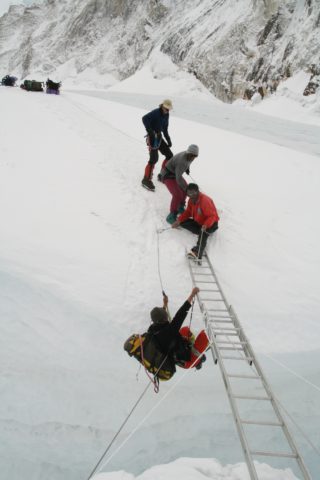
Approaching the ladder, you pause for an inspection. How many ladders are lashed together? Not too bad if only one, but three, four or more, it sinks in the middle, it bounces. Watching a Sherpa crossing ahead on a four-fer, you see the wobble – left, right, up, down. It is 3D.
The safety lines are in place. You look at the anchors, the place where they are secured to the ground, or more accurately to the snow or ice. The thin nylon line is tied in a squirrelly knot through a hole in a piece of bent aluminum – a picket. That’s all? Looking across the crevasse you see the rope tied to an ice screw, but yesterday’s hot sunlight has the hole has melted out and the ice screw bobs freely.
Dawa looks at you as you take a second carabiner off your harness. He goes first. Clipping in both ‘biners to the two safety ropes on either side of the ladder he steps onto the first rung, then the second and without so much as a pause he is across standing there staring at you. You can almost hear him in a deep John Wayne voice “OK kid, I showed you how to do it, now get on with it.”
Knowing you have little choice, you approach the ladder as one would approach one of those monkeys you saw in Kathmandu. Carefully, slowly, you move your feet towards the edge. Bending over, you grab the right-hand safety line, then with your other hand, you press the locking mechanism of your carabiner inwards and clip onto the line. Repeating this procedure, you are now hooked onto both safety lines. Your life is now in the hands of the makers some space-age technology that is used mostly in socks!
Your crampon’s front points jut out from your boot as you focus your eyes on the first rung. The question is whether to put the mid part of your sole on the rung or to gingerly put your front points on one rung and the back of your boot on the trailing rung. The latter runs the risk of being caught when you lean forward, forcing the rung tightly against your crampons. Only a Cirque du Soleil move would allow you to free yourself.
Seeing the Sherpas make this move gives you confidence so you move forward. The right boot settles on the ladder, then your left foot moves quickly in place. You hold onto the ropes with a grip so tight that if you fell, your shoulder would dislocate before your grip would release.
Your hands are slightly behind you to pull the line taught. All of a sudden, the line goes tight from both sides. Teammates have squatted at both ends of the ladder to pull the rope tight making it more of a rail. You appreciate this and return the favor at the next crossing.
One step is followed by the next and then a third. Your eyes focused on the ladder, your boot, your knee – anything other than the seemingly bottomless pit below you. In the middle of the span, you realize you have not taken a breath. At 18,000 feet, this is a big mistake. You pause and take a big breath.
Looking up, you see Sherpas, strangers and a black dog looking at you, wondering. You wonder as well. It’s now obvious that your slow pace is holding up th , well you are delaying the dog … Your humility lessons continue.
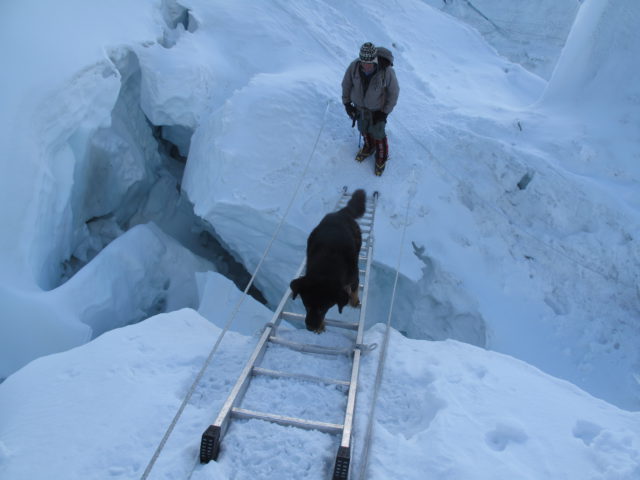
A few more steps, your foot reaches the snow covered ground. You take another deep breath. Unclipping, you stand up straight, you had been slouching the entire time. Your mother would be unhappy. Looking around you feel good. The dog bounds up the ladder and leaves you behind!
real dangers
The climb through the Icefall continues touching the famous points: first ladder, football field, popcorn, the high ladders at the top. Just when you think its all over, the route turns in on itself. Now a small yellow glow is illuminating the area. Good you think, the daylight will bring strength but also instability. You pick up the pace.
The final steps at the top of the Icefall is someone’s idea of a really, really poor joke. After gaining almost 610-meters/2,000-feet, haven’t you paid the price to the Troll? Apparently not as a set of two vertical ladders present themselves to you. Make that two sets of six ladders lashed together to help you as an aspiring ice climber scale a 30-meter/100-foot ice wall. John Snow would be saddened you used ladders.

Just before the Game of Thrones Ladder section, Dawa has grown a bit impatient with you and the gap widens. You know you are almost to Camp 1 so, this doesn’t worry you. As the area lights up, you pass a silly high vertical ice serac. It looks like something King Kong would scale and beat his chest from the top. You really don’t give it any notice as you pass. The terrain is pretty flat, you are walking on a snow covered sidewalk for a short distance. Looking ahead you see the ladders and then you hear it – a huge crash and explosion of ice … the Tower had fallen directly onto the route where you and Dawa were just moments earlier.
Dawa stops in his tracks look back at the evidence of the collapse, a handful of refrigerator sized ice blocks cover the trail along with millions of tiny ice blocks. He looks at you. You look at him. No words need to be exchanged. You move on.
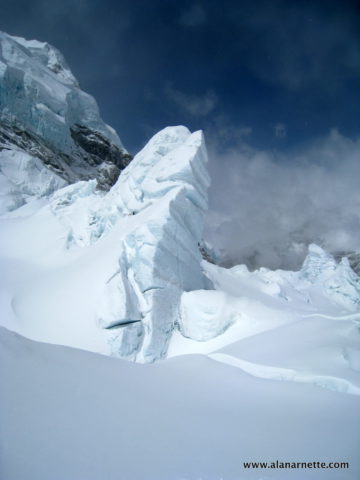
Serious Sunrise
Somehow, you overcome the ladders and enter the Western Cwm. And then reality sets in. You thought at the top of the Icefall it would be an easy sidewalk saunter to Camp 1. But Nooooooo, more ups and downs, more ladders to scale. Dawa glances at you as he moves on putting on his sunglasses already out knowing at the top of the Icefall it is full on George Hamilton bright sun. You stop, take off your pack, search in each pocket for the $250 sunglasses you bought so that you would not get snow blindness. You finally find them just as your eyes are in pain and drying out. Best laid plans.
You try to keep up with Dawa as he, once again, floats across the lower Cwm. You are seriously tired, seriously dehydrated and have a serious crisis of confidence. About that time, Dawa pauses at the top of one of the endless glacier ditches. When you arrive at the top, complete with all your neurosis being exposed, you look down at your yellow boots against the pure white snow that was created from Everest and Lhotse snowfall.
“We made good time.” Dawa simply says and trots off.
Stunned, you are now the world’s best climber!! Certainly better than any one else on your team even though half of them are already at Camp 1. Yes!!! Yes!! You Win!!!
Camp 1
Finally arriving at Camp 1, once again you’re humbled by the accuracy and attention to detail of the Sherpas. A row of eight yellow tents are precisely lined up. This time you will share with a tent mate. You two have already bonded so its an easy choice and your find you tent. Your pack drops heavily to the ground. Standing up, you look around for the first time. OMG. Lhotse steals the view but Nuptse to your right is very impressive. You pause thinking of Ueli Steck. And to your left is the mother of mountains.
You unstrap your pad from the outside of your pack and then pull your -29C/-20F full down sleeping bag out of your pack. You unroll it, throw it on top of your pad and slide in next to your tent mate. Lying on top of the ethically sourced down sleeping bag that will keep you warm at the South Col when it is -29C/-20F, it dawns on you … It’s well over 38C/100F inside the tent.
Not a whiff of wind, no movement of air. You are now at 5,942-meters/19,500-feet laying on layer of moving glacial ice and you are on fire. The black dog comes over for a snack.
Welcome to the Camp 1
Climb On!
Alan
Memories are Everything!
Alan crossing a ladder from my 2008 climb:
And a video I took in 2014 after the earthquake flying over the Khumbu Icefall:
Climb On!
Alan
Memories are Everything

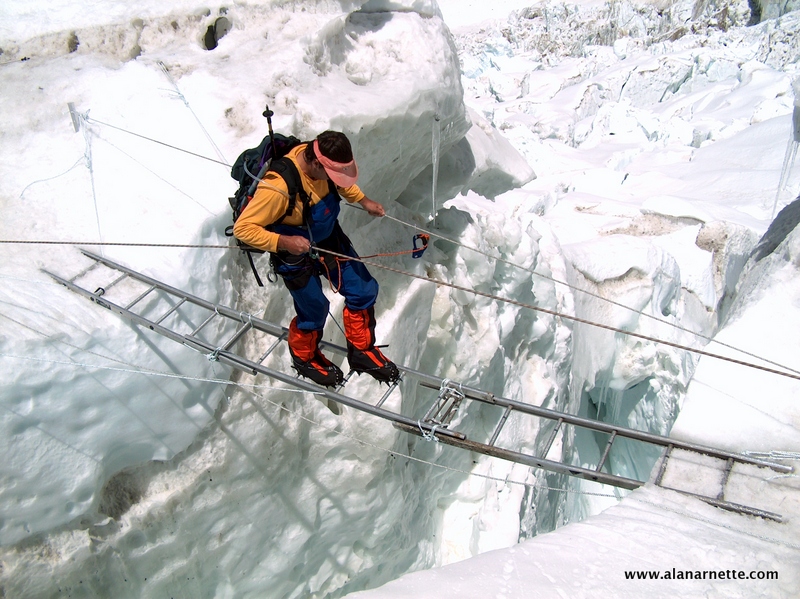
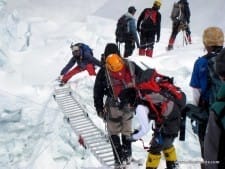
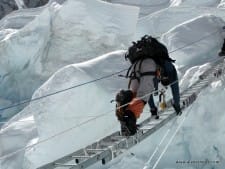
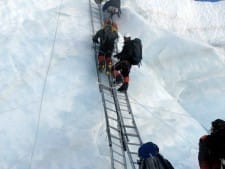
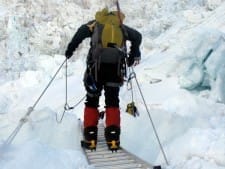
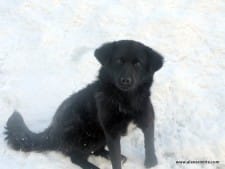
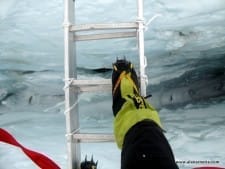
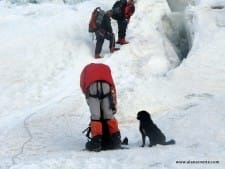
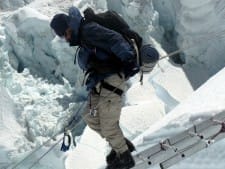
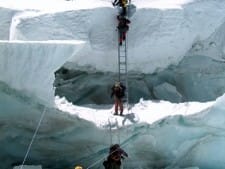
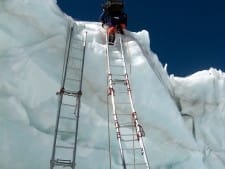
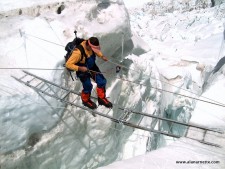
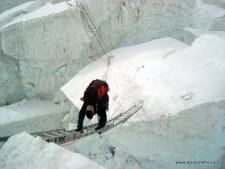
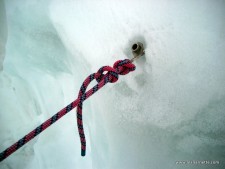
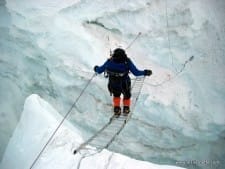


8 thoughts on “Everest 2019: Facing Fears”
So beautifuly written.
Thank you Nicole
A brilliantly written post Alan, as ever I’m really enjoying your 2019 coverage.
Thanks for taking the time Patrick to comment. Appreciate it.
Back for another exciting year on Everest beautifully narrated by Alan!
As always, thank you Ann. Heres to a safe season for all.
Fantastic writing. As always Alan!
Thanks Jacqueline. Based on my own experiences so it brings back good memories for em as well.
Comments are closed.